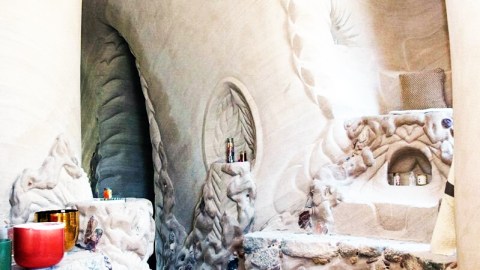Transcendent Art That Brings Us Back To Earth

As someone who survives, emotionally and financially, from artistic inclinations, I understand the struggle between creating and economics. One bothersome trend is this persistent idea that you should work — write, compose music, perform — “for exposure.” Translation: Company gets free labor; you get no money. This mentality plagues numerous freelancers in the digital age, and shows no sign of slowing.
A kernel of truth can be plucked from this, however. There is something primordial and necessary in creating art. We all want to be rewarded for our efforts, but given the sheer volume of people striving for identical goals, the field winnows down quicker than GOP presidential candidates. While the notion of “pure creation” is a misnomer — to tap into your creative channels, you need the basics covered — there exists beyond financial gain silent satisfaction when engaged in an artistic pursuit.
I’m not sure how Ra Paulette survived for two decades in such a pursuit, but in the face of his tremendous work that seems irrelevant. At age 50, he began carving intricate sanctuaries into soapstone mountains. The spectacular caves he is now famous for did not exist; in the American Southwest he’s found 20 locations to burrow into the side of a mountain and create something majestic.
In need of a vacation, my girlfriend and I visited one such cave in New Mexico this past week. Flying into Albuquerque on Monday, we drove about 45 minutes north of Santa Fe Tuesday morning for a guided tour of Paulette’s “Windows of the Earth Cave Sanctuary.”
(His caves are on private land, often commissioned. Our guide told us that his 900 hours of work averaged out to $12 an hour, or $10,800. It took him two years to complete.)
The drive alone is spectacular. Although my second time visiting New Mexico, I was taken aback by the mountainous terrain, varied wildlife, a light blanket of snow sleeping atop a desert floor with its endless serenade of saguaros. A lifelong coastal resident, first East and now West, it’s easy to forget just how beautiful America is (which is why we opted to drive back to Los Angeles).
After stopping in Santa Fe for a strong cup of coffee, we ascended the 285 to Rancho de San Juan. The hike from the tour company’s lodge to the cave is about a third of a mile, a quick ascent at an already-elevated landscape. Our guide took brief breaks to let everyone’s sea-level lungs acclimate. And then we approached the cave’s entrance.
You’re not allowed to take photos inside of the cave — our guide told us that Paulette meant his caves to be places for meditation. Life lived through a constant screen seems a life lived one step removed from reality. Our culture’s great tragedy is our neurological and emotional addiction to devices. This space, thankfully, invites reflection, not announcement.
(The first link above features images of the cave’s insides. You can view our hike up here, here, and here.)
To imagine one man digging with a simple shovel and backpacking a wheelbarrow to carve this cave is boggling, almost more so than the actual result. Those committed to a passion know this: Art resides in the drive, not completion. As soon as the work is done, there’s more to do.
While the catchwords used around this cave include “heavens,” “healing,” and “sacred,” I’m more fascinated by the mental process and emotional commitment of Paulette. I never understood why one land is sacred and another profane; the gesture is arbitrary and inflated. As Joseph Campbell once remarked, any land is sacred if the observer deems it so.
Forget divine, the reptilian geometry of Paulette’s skilled hands appeal to something biological in us. As Oliver Sacks writes in Hallucinations, the patterns we see when under the influence of LSD, ayahausca, and mescaline are probably an exploitation of our visual system’s basic operating procedures. Our brain seeks patterns in everything: clouds, mountains, Jesus on a slice of bread. So-called “sacred geometry” is nothing more than an evolutionary process that resulted in human eyesight — fascinating, though not metaphysical.
This does nothing to dispel the beauty of it all. Just like that landscape of hills and saguaros we spent miles traveling through, Paulette accomplished what every great artist strives for: mimicking and repeating nature, boring gorgeous patterns into stone. Both process and result appeal to our innate sense of connectedness to this world, what I would actually label “healing” in an all-too-often disconnected culture.
Our brain is an instrument that both harms and heals, that creates illusions for itself to fall victim to as well as offer solutions to itself for an escape. Artists like Paulette tap into this boundless reservoir of imagination and determination and bring forth a gift, which is especially pertinent and meaningful in an age when agenda-driven politicians threaten to shut down the EPA and capitalize upon our natural resources.
So while this particular cave is dedicated to the heavens, much work here on Earth remains to be done. This is not to deny anyone’s attempt at ascension: As Aldous Huxley noted, humanity’s greatness is in this eternal quest. If that quest reminds us of staying connected to this Earth, then we can spend a moment enjoying such transcendent art before returning to our own mission.
Image: Origin New Mexico
—
Derek Beres is a Los Angeles-based author, music producer, and yoga/fitness instructor, currently working on his new book, The Valencia Filter: How Our Imagination Influences Religion, Politics, Sexuality, Nutrition, and Beyond. Stay in touch @derekberes.




